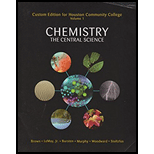
To determine: The ways in which using the principle, “it is better to use as few steps as possible in making a new chemical” advances the goals of green chemistry and relation between this principle and energy efficiency.
Answer to Problem 1DE
Explanation of Solution
It is better to use as few steps as possible because the lesser the number of steps, the lesser the production of wastes. This is also one of the goals of green chemistry that says it is better to prevent waste than to clean it up after it has been created.
Moreover, synthesizing a chemical using less number of steps would minimize the use of energy. As energy is involved in each chemical process, lesser number of steps would lead to energy efficiency.
One of the goals of green chemistry emphasizes on prevention of waste generation that is possible if lesser number of steps are used in making a chemical. Less number of steps also means less energy usage that is energy efficiency.
Want to see more full solutions like this?
Chapter 4 Solutions
CHEMISTRY:CENTRAL SCI.,V.1-PKG.>CUSTOM<
 ChemistryChemistryISBN:9781305957404Author:Steven S. Zumdahl, Susan A. Zumdahl, Donald J. DeCostePublisher:Cengage Learning
ChemistryChemistryISBN:9781305957404Author:Steven S. Zumdahl, Susan A. Zumdahl, Donald J. DeCostePublisher:Cengage Learning ChemistryChemistryISBN:9781259911156Author:Raymond Chang Dr., Jason Overby ProfessorPublisher:McGraw-Hill Education
ChemistryChemistryISBN:9781259911156Author:Raymond Chang Dr., Jason Overby ProfessorPublisher:McGraw-Hill Education Principles of Instrumental AnalysisChemistryISBN:9781305577213Author:Douglas A. Skoog, F. James Holler, Stanley R. CrouchPublisher:Cengage Learning
Principles of Instrumental AnalysisChemistryISBN:9781305577213Author:Douglas A. Skoog, F. James Holler, Stanley R. CrouchPublisher:Cengage Learning Organic ChemistryChemistryISBN:9780078021558Author:Janice Gorzynski Smith Dr.Publisher:McGraw-Hill Education
Organic ChemistryChemistryISBN:9780078021558Author:Janice Gorzynski Smith Dr.Publisher:McGraw-Hill Education Chemistry: Principles and ReactionsChemistryISBN:9781305079373Author:William L. Masterton, Cecile N. HurleyPublisher:Cengage Learning
Chemistry: Principles and ReactionsChemistryISBN:9781305079373Author:William L. Masterton, Cecile N. HurleyPublisher:Cengage Learning Elementary Principles of Chemical Processes, Bind...ChemistryISBN:9781118431221Author:Richard M. Felder, Ronald W. Rousseau, Lisa G. BullardPublisher:WILEY
Elementary Principles of Chemical Processes, Bind...ChemistryISBN:9781118431221Author:Richard M. Felder, Ronald W. Rousseau, Lisa G. BullardPublisher:WILEY





